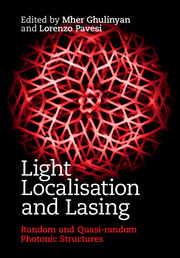Book contents
- Frontmatter
- Contents
- List of contributors
- Preface
- 1 Light propagation and emission in complex photonic media
- 2 Transport of localized waves via modes and channels
- 3 Modes structure and interaction in random lasers
- 4 Ordered and disordered light transport in coupled microring resonators
- 5 One-dimensional photonic quasicrystals
- 6 2D pseudo-random and deterministic aperiodic lasers
- 7 Three-dimensional photonic quasicrystals and deterministic aperiodic structures
- 8 Cavity quantum electrodynamics with three-dimensional photonic band gap crystals
- References
- Index
Preface
Published online by Cambridge University Press: 18 December 2014
- Frontmatter
- Contents
- List of contributors
- Preface
- 1 Light propagation and emission in complex photonic media
- 2 Transport of localized waves via modes and channels
- 3 Modes structure and interaction in random lasers
- 4 Ordered and disordered light transport in coupled microring resonators
- 5 One-dimensional photonic quasicrystals
- 6 2D pseudo-random and deterministic aperiodic lasers
- 7 Three-dimensional photonic quasicrystals and deterministic aperiodic structures
- 8 Cavity quantum electrodynamics with three-dimensional photonic band gap crystals
- References
- Index
Summary
This book is the result of our interest in understanding, mastering, and engineering randomness in photonic systems. It is a natural consequence of what we did in the past. In the late 1980s, while Lorenzo Pavesi was working on semiconductor superlattices he noticed that for some energies the vertical transport through the superlattice minibands was inhibited due to disorder (L. Pavesi et al. 1989. Phys. Rev. B, 39, 7788). Then, working on the recombination dynamics of excitons in porous silicon, he further noticed that the random arrangement of silicon quantum dots has a strong influence on the recombination dynamics of excitons(L. Pavesi et al. 1993. Phys. Rev. B, 48, 17625). After Mher Ghulinyan came to Trento in 2002, we developed the techniques to fabricate free-standing porous silicon dielectric multilayers of any stacking sequence (M. Ghulinyan et al. 2003. J. Appl. Phys., 93, 9724). This was the first time that we had the chance to designat will one-dimensional periodic, aperiodic, or random photonic systems. A fascinating new physics opened up for us: that of the analogy of photon propagationin complex dielectric systems with carrier transport in random electronic systems. Our latest results in the field are associated with sequences of ring resonators where randomness causes the formation of resonant coupling between different rings with the possibility of yielding the optical analog of the electromagnetic induced transparency (M. Mancinelli et al. 2011. Opt. Express, 19, 13664), or chaotic photon propagation.
Over all these years, we have had the chance to interact with many researchers active in the field of periodic, quasiperiodic, and random photonic systems. From these interactions the idea of this book was born. We have therefore collected together a series of self-contained chapters to cover the whole field with the specific aim of introducing the different aspects, showing the current status of the research, and envisaging future directions. All invited authors have responded to this challenge with great enthusiasm and professionalism.
The book opens with Chapter 1 by W. L. Vos, A. Lagendijk, and A. P. Mosk, which introduces the field and covers the timeline between the early studies on these systems and the very latest achievements in the field.
- Type
- Chapter
- Information
- Light Localisation and LasingRandom and Pseudo-random Photonic Structures, pp. xi - xivPublisher: Cambridge University PressPrint publication year: 2014



